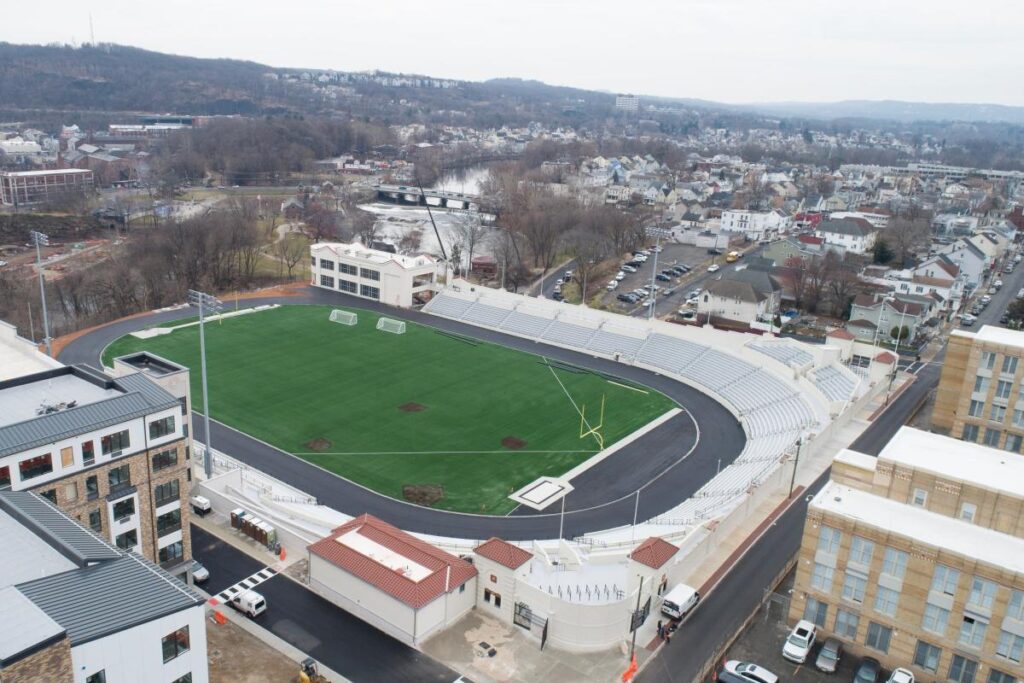Hincliffe Stadium’s renovation in Paterson, New Jersey, has seen considerable development over the past year and a half, yet the newly constructed restaurant space at the historic ballpark remains vacant, raising concerns about its future operations. The renovation project, which was first estimated to cost $93 million, included the construction of a dual-purpose building featuring a museum dedicated to Negro League baseball and a restaurant. While the museum on the second floor opened in April, the restaurant area remains empty, signaling financial difficulties faced by the developers. Insiders affiliated with the project suggest that funds ran out, halting progress on the restaurant’s interior and equipment installation.
As costs escalated during construction, the total financial outlay surged to around $109 million, as revealed by documents from the New Jersey Economic Development Authority (NJEDA). This oversized budget includes funds allocated for repairing the stadium, creating a 315-space parking garage, and the addition of a 75-unit apartment building. Requests for updates from Mayor Andre Sayegh regarding the operational status of the food court have gone unanswered, further indicating the project’s tumultuous economic condition. Despite early assurances from Sayegh that the renovated stadium would house a high-end dining option offering views of the Great Falls, the developers failed to secure a suitable tenant and ultimately downgraded their vision to a more typical food court model.
Baye Adofo-Wilson, one of the developers, acknowledged that market conditions have shifted due to inflation and rising construction costs, complicating potential agreements for the food court’s debut. While discussions are reportedly underway to explore alternative solutions, there is currently no timeline for when the food court will become operational. Interestingly, a company owned by Vaughn McKoy, a former business administrator for Sayegh, obtained the concession contract, which includes the food court and refreshment stands at the stadium. Although the refreshment stands have been active, McKoy has not provided clarity about the food court’s timeline, often deferring inquiries back to the developers.
The lack of transparency surrounding the concession and food court contract has drawn scrutiny, particularly when it comes to public disclosure. Official documents indicate that the agreements between Paterson City Hall, the Board of Education, and the developers omit requirements for such disclosures. Consequently, financial details regarding the lease with the New Jersey Jackals, a minor league baseball team, remain undisclosed. Furthermore, NJEDA’s electronic documentation reveals substantial portions of text were redacted, with state officials noting that these restrictions were requested by the developers who claim the information comprises proprietary commercial data that could benefit competitors if made public.
Councilman Michael Jackson has emerged as a vocal critic of the current administration’s handling of the Hinchliffe project, expressing concern over the confidentiality surrounding significant financial documents related to a public venue. His pointed inquiries, including calls for investigations into the opacity of financial information, highlight the tension between governmental accountability and private enterprise dealings in public facilities. As the project stagnates, challengers of the status quo demand clarity and transparency, underscoring the potential implications for community trust and engagement in local development efforts.
As the situation with Hinchliffe Stadium continues to evolve, the pressing need for a viable food court and restaurant has led to broader discussions about community accountability. The stalled operation raises questions about managing public assets, the overall transparency of public-private partnerships, and the responsibility of government officials to disclose relevant financial information. Since the reopening of the stadium more than 500 days ago, the challenge remains: how will the developers, local government, and community stakeholders work to propel the project forward and meet the expectations set at the outset of this ambitious renovation?

